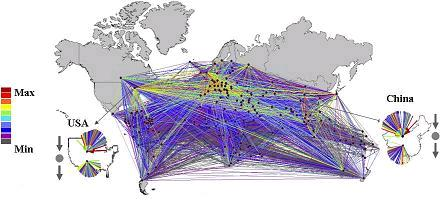June 11, 2008 feature
Researchers develop a worldwide tourism network

It wasn't too long ago in human history that people rarely, if ever, traveled beyond the village they were born in. We've come a long way since then: according to the World Tourism Organization (WTO), international traveler arrivals peaked at 763 million in 209 countries and territories in 2004. The WTO expects that number to reach 1.6 billion by 2020, making international travel one of the fastest growing economic sectors.
But where do all these people go? And where do they come from? Further, what is the relationship among countries that are popular or unpopular tourist destinations? Mathematician Joana Miguéns and physicist José Mendes, both from Aveiro University in Portugal, have developed a worldwide tourism network to help investigate some of these questions. Besides revealing information on human traveling patterns, the network will also likely help researchers understand information transfer and global wealth flows, since tourism accounts for more than 10% of the world’s gross domestic product.
Miguéns and Mendes used 2004 data from the WTO, which defines tourism as “the activities of persons traveling to and staying in places outside their usual environment for not more than one consecutive year for leisure, business, and other purposes.” In the researchers’ model, links between countries represent tourist arrivals from one country to another. The network is both directed and weighted – directed in that the links are one-way, and weighted in that links become stronger as the number of traveler arrivals increases.
In their analysis, the researchers found that the network is very strongly directed. Specifically, if one country has tourists visiting from another country, there is only a 25% probability that the second country will have tourists visiting from the first country. And, despite the large numbers of travelers, the overall connectivity of the network is lower than might be expected. A full 60% of all pairs of countries are not connected to each other, meaning they don’t exchange tourists at all.
Another interesting feature of the world tourism network is that, in at least one way, it behaves more like an economic network rather than a social network. In the tourist network, countries with a high degree (those that are popular tourist destinations) are more likely to be neighbors with countries with a low degree (less popular tourist destinations). This behavior is similar to economic and transportation networks, which have patterns where popular central hubs have many inbound connections from peripheral nodes. As the researchers note, this finding could question the common notion of culture as the driving force of tourism.
“In general, social networks are of an assortative type, where hubs connect to hubs,” Miguéns told PhysOrg.com. “Here we observe a different structural topology, with disassortative behaviour, more characteristic of technologic and economic networks, where hubs connect with small-degree nodes. More recent results also show that, on the level of clustering coefficients, the same characteristic behaviors of nonsocial patterns are observed.”
The researchers also found that, overall, the world tourism network is scale-free over four orders of magnitude. The network changes in scale, but not in relation, even as the number of travelers dramatically increases or decreases. So as travelers increase, as expected, it’s the countries that are already the popular tourist destinations that are more likely to add new connections. This scale-free nature, which contrasts with the random topology expected of heterogeneous networks, opens up an entirely new class of networks.
“Contrarily to the results obtained recently for the worldwide air network (where a scale-free network was observed), the results for the tourism network are – from the point of view of degree of different countries – similar to a random network,” Miguéns said. “A scale-free network is obtained when we have in consideration the traffic weight between countries. The way to understand the concept of preferential attachment seems from our point of view related with a kind of ‘social phenomenon’: marketing, travel promotion, word-by-mouth, etc.”
More information: Miguéns, J. I. L. and Mendes, J. F. F. “Travel and Tourism: into a Complex Network.” Physica A, Volume 387, Issue 12, 1 May 2008, Pages 2963-2971. Also available at: arXiv:0805.4490v1. 29 May 2008.
Copyright 2008 PhysOrg.com.
All rights reserved. This material may not be published, broadcast, rewritten or redistributed in whole or part without the express written permission of PhysOrg.com.





















